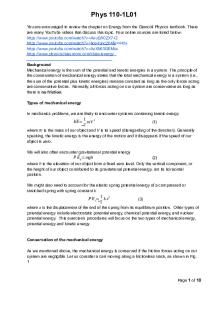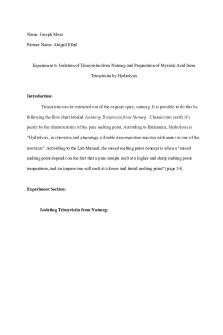EE224 Lab 5 Report PDF

| Title | EE224 Lab 5 Report |
|---|---|
| Course | Signals and Systems |
| Institution | Iowa State University |
| Pages | 7 |
| File Size | 430.9 KB |
| File Type | |
| Total Downloads | 41 |
| Total Views | 141 |
Summary
EE 224 Lab Report ...
Description
EE224 Lab 5 Report John DiBasilio & Taylor Semple Section 2 Wednesday 9:00 am
Introduction: In this lab, we will be looking at different kinds of data for different images and then be able to alter the images. One kind of alteration will be to use histogram equalization to spread out the pixels on the grayscale histogram. The grayscale is different levels of pixels from values 0-255. We will then use image intensity processing to white out the background on the cells image. This is used to be able to easily count how many nuclei are in the cells image. 1. Original image and histogram of pout.tif
2. What is the range of the pixel intensity values of the original image? The range of the intensity of the original image is approximately 77-159. This means that there are only pixels of this intensity on the grayscale present in this image. 3. Give two methods for increasing the range of the image intensity from part 3 above. Describe and implement the methods and show the results of the operations in your lab report. Compare the results in both cases, does one method work better than the other? One method, for increasing the range of the intensity is using the histogram equalization operation which will try distribute the pixels across the spectrum as equally as possible. Another method is to use Contrast Stretching to stretch the pixels across the spectrum as much as possible. a. Histogram Equalization
This method uses the function histeq(IMG) to stretch the intensity across the entire grayscale spectrum of 0 to 255. b. Contrast Stretching
This is the Contrast Stretching method where again the pixels are stretched across the grayscale. We think the Histogram Equalization method works better because the histogram is more stretched across the spectrum and the image shows up brighter and clearer. 4. First we made the cell image into grayscale. We then made a for loop to isolate the black intensity pixels in the image. We started off just having a for loop with just an if statement, as you can see by our first image. We then added an else statement to get rid of scattered lines
through out the image and make the nuclei more distinct. We also changed the intensity barrier from 75 to 35.
Conclusion: In this lab, we were able to do different image processing to different photos using MATLAB codes. We started off using two different processes to increase the intensity range of the image. The first process we used was called, “Histogram Equalization”, where we used the Histeq function in MATLAB to stretch the image intensity. This was a very simple code and was easy to write. The second process we used was called “Contrast Stretching”, where we used the Imadjust function. This went pixel by pixel and was able to stretch it out across the grayscale. The Histogram Equalization technique worked better because the range of pixels was stretched more equally across the grayscale histogram. The next task in the lab was to use image intensity processing to white out any pixel that was not a nucleus. Since the nuclei were black in color, we used a for loop to go through each image and check to see if the intensity of the image was under 75. 75 did not work too well, so we had to adjust it to 35. If the pixel was under 35, we then set it to 0 so all nuclei were the same color black....
Similar Free PDFs

EE224 Lab 5 Report
- 7 Pages

LAB 5 - Lab report
- 4 Pages

Lab Report 5 - lab
- 5 Pages

Lab 5 - Lab report
- 6 Pages

Lab 5 - Lab experiment report
- 6 Pages

Lab 5 Lab Report- (Microbiology)
- 4 Pages

Phys lab 5 - Lab report
- 10 Pages

Experiment 5 - Lab Report 5
- 16 Pages

Post Lab Report Lab 5
- 5 Pages

Lab 5 Report
- 5 Pages

Chem lab report 5
- 7 Pages

Lab 5 Report
- 8 Pages

EX 5 lab report
- 10 Pages

Lab Report 5
- 8 Pages

Lab Report 5
- 16 Pages

Lab report 5
- 13 Pages
Popular Institutions
- Tinajero National High School - Annex
- Politeknik Caltex Riau
- Yokohama City University
- SGT University
- University of Al-Qadisiyah
- Divine Word College of Vigan
- Techniek College Rotterdam
- Universidade de Santiago
- Universiti Teknologi MARA Cawangan Johor Kampus Pasir Gudang
- Poltekkes Kemenkes Yogyakarta
- Baguio City National High School
- Colegio san marcos
- preparatoria uno
- Centro de Bachillerato Tecnológico Industrial y de Servicios No. 107
- Dalian Maritime University
- Quang Trung Secondary School
- Colegio Tecnológico en Informática
- Corporación Regional de Educación Superior
- Grupo CEDVA
- Dar Al Uloom University
- Centro de Estudios Preuniversitarios de la Universidad Nacional de Ingeniería
- 上智大学
- Aakash International School, Nuna Majara
- San Felipe Neri Catholic School
- Kang Chiao International School - New Taipei City
- Misamis Occidental National High School
- Institución Educativa Escuela Normal Juan Ladrilleros
- Kolehiyo ng Pantukan
- Batanes State College
- Instituto Continental
- Sekolah Menengah Kejuruan Kesehatan Kaltara (Tarakan)
- Colegio de La Inmaculada Concepcion - Cebu